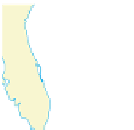Geoscience Reference
In-Depth Information
Tropical Cyclones
an easterly wave, including the axis, wind flow patterns, and
precipitation zone.
If the storm strengthens into a
tropical depression
, it
begins to rotate cyclonically around a definable center of low
pressure at the same time that a complex of strong thunder-
storms develops. At this time, sustained winds in the center of
the system are 20 knots to 34 knots (23 mph to 39 mph). If the
storm continues to strengthen and maximum sustained winds
are between 35 and 53 knots (35 and 73 mph), it becomes a
tropical storm
. The storm at this point begins to become
more circular in shape and is assigned a formal name (such as
Charlie
) for monitoring purposes as it proceeds on its easterly
migratory path.
Now it is time to turn our attention to cyclonic storms that form
in the tropical regions. Although tropical systems are similar to
midlatitude systems because they are rotating low-pressure sys-
tems, they differ significantly because they form in geographi-
cal regions where there are no fronts or contrasting air masses.
Instead, a tropical cyclone develops entirely within a homoge-
neous air mass at very low latitudes. As a result, abundant water
vapor and latent heat are present to fuel these systems. About 80
tropical cyclones develop around the world every year, with the
strongest becoming extremely powerful storms that, depend-
ing on the part of the world, are called hurricanes, typhoons,
or cyclones.
Most Atlantic hurricanes form in association with an at-
mospheric feature called an
easterly wave
, which is a slow-
moving trough of low pressure that migrates along the belt of
tropical easterlies. Recall that this belt is associated with the
easterly trade winds and occurs between 5° and 25° N and S
latitude. This low-pressure system causes air to converge on
the windward (east) side of the trough axis, while air diverges
in the lee (west) side of the system. The convergence of upper
air on the eastern side of the wave causes further convectional
uplift within the system, and a zone of showers develops paral-
lel to the trough axis. Figure 8.21 shows the basic structure of
Hurricanes
If a tropical storm in the Atlantic Ocean or eastern Pacific Ocean
strengthens to the point that the maximum sustained winds are
greater than 63 knots (73 mph), then it officially becomes a
hurricane
. A storm of similar strength in the western Pacific
Ocean is called a
typhoon
or a
cyclone
if it forms in the Indian
Ocean. Australians call such a storm a
willy nilly
because they
twist about and wreak havoc. For purposes of discussion here,
we use the term
hurricane
and focus on Atlantic storms.
Although it is common to hear the word
hurricane
, storms
of this magnitude are really quite rare because they require a
30
°
N
Direction of
tropical easterlies
Streamlines showing
airflow at 1500 m
Zone of
showers
20
°
N
Figure 8.21 Characteristics of a tropical wave.
Tropical
waves consist of a center of surface low pressure that results
in the convergence and divergence of air aloft. Showers de-
velop on the eastern side of the wave axis because converg-
ing air causes convectional uplift.
Axis of Equatorial
trough at 1500 m
10
°
N
80
°
W
70
°
W
60
°
W
Easterly wave
A slow-moving trough of low pressure that de-
velops within the tropical latitudes.
Tropical storm
A tropical low-pressure system with maxi-
mum sustained winds between 35 knots and 63 knots (39 mph
and 73 mph).
Tropical depression
A tropical low-pressure system with
central sustained winds ranging between 20 knots and 34 knots
(23 mph and 39 mph).
Hurricane
A tropical circulatory system with maximum sus-
tained winds greater than 63 knots (73 mph).





























































































































































































































































